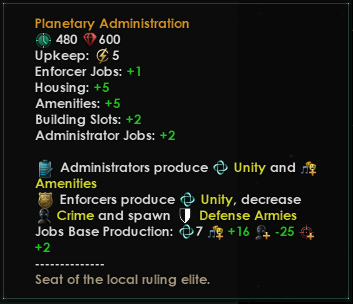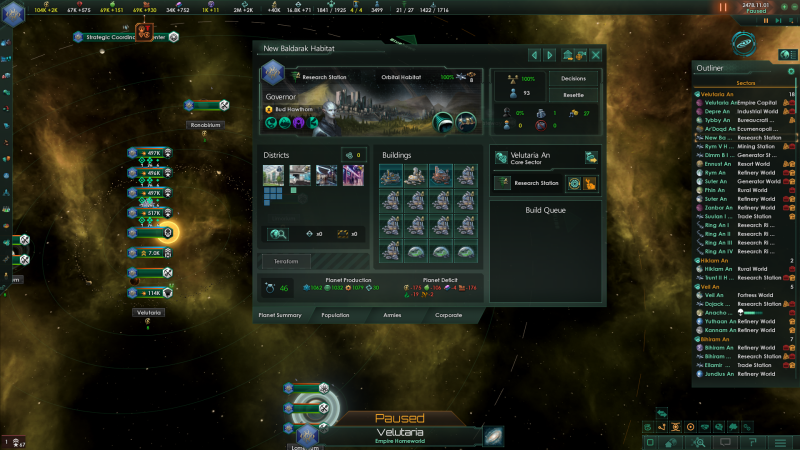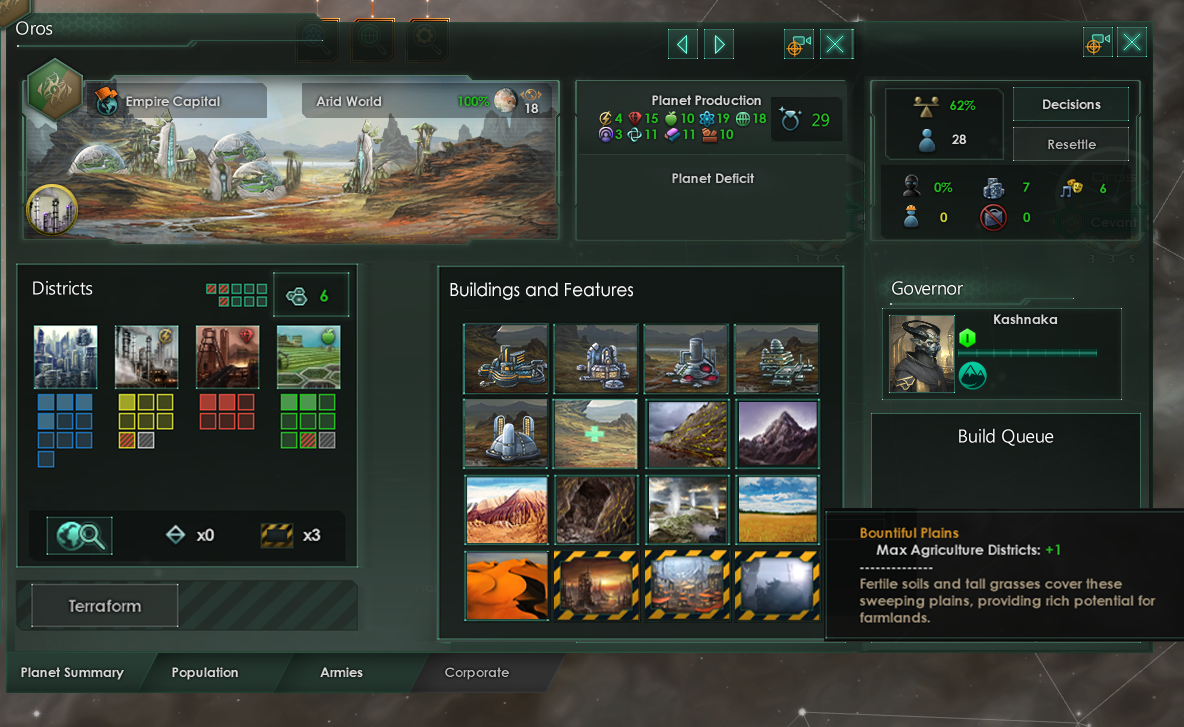Hi everyone!
Way back in Dev Diary 152, we discussed some planetary changes that we experimented with during summer 2019. At the time, we decided that while we learned a lot from the experiment, they required significant additional refinement before being something we wanted to incorporate into Stellaris.
Summer 2020 gave us the additional time we needed to revive these (and some other) experiments. Our primary objectives were to reduce the mid to late game micromanagement burden and provide quality of life improvements, including generally making the prebuilding of planets more viable, making planetary automation reliable enough to be trusted in the mid to late game, and making dealing with unemployment and pops easier.
We’ll be talking about these subjects in multiple dev diaries over the next couple of months.
Industrial Districts

Azure Chalice is… er, was... a lovely place.
The planet view has shifted things around a bit and now supports the display of up to six district types. Most planets will have five district types available. This extra real estate could also be of special interest to modders.
The new brownish-orange district next to the City District is the revived Industrial District. Industrial Districts are treated as urban districts (and as such are not limited by planetary features), but rather than the Laborers that split their output from the original experiment, we’ve decided to have the districts provide regular empires one Artisan and one Metallurgist job. Gestalts have either two Foundry Drones or Fabricators as appropriate.

Work, work, work.
Factories and Foundries will still exist but are now planet unique, with the first tier building adding 2 jobs to the planet just like the old versions. The upgraded versions, however, will now add either 1 or 2 jobs of the appropriate type to each Industrial District on the planet.
Ecumenopoli will retain their specialized districts, but can be boosted by the Foundry or Factory buildings. The number of jobs per district on ecumenopoli have been adjusted somewhat as part of an overall economic balance pass. Since Industrial Districts are considered urban, a planet with a mix of City and Industrial Districts can be paved over and turned into an Ecumenopolis using the Arcology Project decision.
Since districts are now much more critical to the development of your civilization, the average size of homeworlds has been increased by 2, and as an additional side effect, the Mastery of Nature Ascension Perk may also become a bit more desirable.
Building Slots
I’m sure you’ve already noticed from the above screenshot, Building Slots no longer list population counts. Instead of relying on population, they're opened up by increasing the infrastructure of the planet. This is generally done by building City Districts (or their equivalent) or by upgrading the colony's Capital building. As a pleasant side effect of this, your buildings will no longer get ruined when a pop gets resettled, ritually killed, or eaten by mutants.


Build up that infrastructure.
Two new technologies that unlock additional Building Slots have also been added, Ceramo-Metal Infrastructure and Durasteel Infrastructure. They represent the civilian adoption of military technology, and as such require some government techs and the associated armor technologies. The Adaptability tradition tree, for those that have it, still has a tech that grants a Building Slot as well.
As specialized and advanced worlds, Ecumenopoli, Ring Worlds, Hive Worlds, and Machine Worlds start with all of their building slots unlocked.
Habitats are intended to feel a bit cramped, so while Habitation Modules do not open up Building Slots, the Voidborne Ascension Perk will continue to grant two Building Slots to those that choose to embrace living in space.
The MegaCorps out there may ask “but what about our Branch Offices?” - we’ve got you covered.

Insider Trading. Institutionalized corruption exploited by the upper classes, or just greasing the wheels of trade?
Branch Offices will tie their slots to the level of the colony’s capital building. For example, a Planetary Administration building will grant one Branch Office Building Slot, a Planetary Capital will grant two, and a System Capital-Complex would grant three. If the target empire has the Insider Trading tradition, you’ll have one extra Branch Office Building Slot. (This may grant you a Branch Office building even on newly colonized worlds, if your business plan expects it to be profitable.)
But Why?
By decoupling the building unlocks from population growth, it makes it much easier to “prebuild” a planet to varying degrees. It removes some of the tedium of waiting for that last pop to finish growing before a slot unlocks, as well as the negative experience that occurred when a critical pop moved or died right at the wrong time. This change went through many iterations - in one of them the rural and industrial districts added "fractional" slots, in another the capital buildings gave more slots at each upgrade. The combination of having both City Districts and the Capital Building contributing to the slots, along with the additional techs, finally felt right. It's nice when even a newly founded Colony possesses at least one open building slot since it lets you immediately begin construction of a Spawning Pool or other high value building right away.
Moving the essential secondary resources of Consumer Goods and Alloys to districts frees up the building slots a little bit and creates a greater differentiation between heavily urbanized or industrial planets and resource generating colonies. Qualitatively we also felt that it "feels nice" to be getting more of your physical resources from the district level, leaving the Building Slots for more unique and specialized needs.
Both of these changes also happen to make some planetary automation decisions a little easier - your Tech Worlds should clearly build a mix of City and Industrial districts, for instance, to make room for Research Labs as well as to provide the Consumer Goods needed to pay for them. We do recognize that it may be difficult - or even impossible - to unlock all Building Slots on a planet that has not been urbanized, but those resource generating planets often do not have quite as strong a need for a large number of buildings.
Ideally in the mid to late game you could colonize a planet, set the colony designation you want for the planet, turn on automation, and reasonably expect the planet to be in decent shape - and doing what you told it to - the next time you look at it. (In the early game it's certainly possible, but your empire's economy may not be stable enough to support dedicated worlds and your colonies may be better off with direct caretaking.)
We have a few other experiments that are still ongoing that affect the relationship between urbanized vs. less developed planets that are not entirely conclusive yet. If they prove out we'll discuss them later on in this series of diaries. Our current plan for next week's diary is to talk more about the automated colony management overhaul as well as the automatic and manual resettlement of pops.
As a reminder, we have an ongoing feedback thread related to AI improvements we have in beta on the stellaris_test branch. We'd love to get more people on it and telling us what they think about them. (Please note that 2.8.1 is an optional beta patch. You have to manually opt in to access it. Go to your Steam library, right click on Stellaris -> Properties -> betas tab -> select "stellaris_test" branch.)
Thanks!
Way back in Dev Diary 152, we discussed some planetary changes that we experimented with during summer 2019. At the time, we decided that while we learned a lot from the experiment, they required significant additional refinement before being something we wanted to incorporate into Stellaris.
Summer 2020 gave us the additional time we needed to revive these (and some other) experiments. Our primary objectives were to reduce the mid to late game micromanagement burden and provide quality of life improvements, including generally making the prebuilding of planets more viable, making planetary automation reliable enough to be trusted in the mid to late game, and making dealing with unemployment and pops easier.
We’ll be talking about these subjects in multiple dev diaries over the next couple of months.
Industrial Districts

Azure Chalice is… er, was... a lovely place.
The planet view has shifted things around a bit and now supports the display of up to six district types. Most planets will have five district types available. This extra real estate could also be of special interest to modders.
The new brownish-orange district next to the City District is the revived Industrial District. Industrial Districts are treated as urban districts (and as such are not limited by planetary features), but rather than the Laborers that split their output from the original experiment, we’ve decided to have the districts provide regular empires one Artisan and one Metallurgist job. Gestalts have either two Foundry Drones or Fabricators as appropriate.

Work, work, work.
Factories and Foundries will still exist but are now planet unique, with the first tier building adding 2 jobs to the planet just like the old versions. The upgraded versions, however, will now add either 1 or 2 jobs of the appropriate type to each Industrial District on the planet.
Ecumenopoli will retain their specialized districts, but can be boosted by the Foundry or Factory buildings. The number of jobs per district on ecumenopoli have been adjusted somewhat as part of an overall economic balance pass. Since Industrial Districts are considered urban, a planet with a mix of City and Industrial Districts can be paved over and turned into an Ecumenopolis using the Arcology Project decision.
Since districts are now much more critical to the development of your civilization, the average size of homeworlds has been increased by 2, and as an additional side effect, the Mastery of Nature Ascension Perk may also become a bit more desirable.
Building Slots
I’m sure you’ve already noticed from the above screenshot, Building Slots no longer list population counts. Instead of relying on population, they're opened up by increasing the infrastructure of the planet. This is generally done by building City Districts (or their equivalent) or by upgrading the colony's Capital building. As a pleasant side effect of this, your buildings will no longer get ruined when a pop gets resettled, ritually killed, or eaten by mutants.


Build up that infrastructure.
Two new technologies that unlock additional Building Slots have also been added, Ceramo-Metal Infrastructure and Durasteel Infrastructure. They represent the civilian adoption of military technology, and as such require some government techs and the associated armor technologies. The Adaptability tradition tree, for those that have it, still has a tech that grants a Building Slot as well.
As specialized and advanced worlds, Ecumenopoli, Ring Worlds, Hive Worlds, and Machine Worlds start with all of their building slots unlocked.
Habitats are intended to feel a bit cramped, so while Habitation Modules do not open up Building Slots, the Voidborne Ascension Perk will continue to grant two Building Slots to those that choose to embrace living in space.
The MegaCorps out there may ask “but what about our Branch Offices?” - we’ve got you covered.

Insider Trading. Institutionalized corruption exploited by the upper classes, or just greasing the wheels of trade?
Branch Offices will tie their slots to the level of the colony’s capital building. For example, a Planetary Administration building will grant one Branch Office Building Slot, a Planetary Capital will grant two, and a System Capital-Complex would grant three. If the target empire has the Insider Trading tradition, you’ll have one extra Branch Office Building Slot. (This may grant you a Branch Office building even on newly colonized worlds, if your business plan expects it to be profitable.)
But Why?
By decoupling the building unlocks from population growth, it makes it much easier to “prebuild” a planet to varying degrees. It removes some of the tedium of waiting for that last pop to finish growing before a slot unlocks, as well as the negative experience that occurred when a critical pop moved or died right at the wrong time. This change went through many iterations - in one of them the rural and industrial districts added "fractional" slots, in another the capital buildings gave more slots at each upgrade. The combination of having both City Districts and the Capital Building contributing to the slots, along with the additional techs, finally felt right. It's nice when even a newly founded Colony possesses at least one open building slot since it lets you immediately begin construction of a Spawning Pool or other high value building right away.
Moving the essential secondary resources of Consumer Goods and Alloys to districts frees up the building slots a little bit and creates a greater differentiation between heavily urbanized or industrial planets and resource generating colonies. Qualitatively we also felt that it "feels nice" to be getting more of your physical resources from the district level, leaving the Building Slots for more unique and specialized needs.
Both of these changes also happen to make some planetary automation decisions a little easier - your Tech Worlds should clearly build a mix of City and Industrial districts, for instance, to make room for Research Labs as well as to provide the Consumer Goods needed to pay for them. We do recognize that it may be difficult - or even impossible - to unlock all Building Slots on a planet that has not been urbanized, but those resource generating planets often do not have quite as strong a need for a large number of buildings.
Ideally in the mid to late game you could colonize a planet, set the colony designation you want for the planet, turn on automation, and reasonably expect the planet to be in decent shape - and doing what you told it to - the next time you look at it. (In the early game it's certainly possible, but your empire's economy may not be stable enough to support dedicated worlds and your colonies may be better off with direct caretaking.)
We have a few other experiments that are still ongoing that affect the relationship between urbanized vs. less developed planets that are not entirely conclusive yet. If they prove out we'll discuss them later on in this series of diaries. Our current plan for next week's diary is to talk more about the automated colony management overhaul as well as the automatic and manual resettlement of pops.
As a reminder, we have an ongoing feedback thread related to AI improvements we have in beta on the stellaris_test branch. We'd love to get more people on it and telling us what they think about them. (Please note that 2.8.1 is an optional beta patch. You have to manually opt in to access it. Go to your Steam library, right click on Stellaris -> Properties -> betas tab -> select "stellaris_test" branch.)
Thanks!



